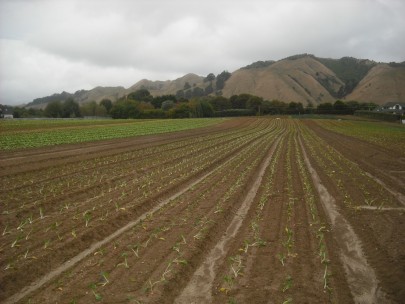Soil quality in the Wellington region

Market garden in the Wellington region
The key soil properties were cadmium (Cd), copper (Cu), zinc (Zn), bulk density, macroporosity, anaerobically mineralised nitrogen (AMN), total nitrogen (TN), Olsen phosphorus, and organic carbon. Cadmium, Cu, and Zn are commonly elevated in agricultural soils due to inputs from fertilisers, fungicides, and animal remedies, respectively. Macroporosity is an indicator of soil compaction. Olsen P is an indicator of plant-available P, organic carbon is an estimate of organic matter content, and TN is a surrogate measure of soil N supply. AMN estimates how much organic N is potentially mineralizable and can be considered biologically active and is also a surrogate measure of the microbial biomass. The 0–10 cm soil depth was sampled.
To provide a perspective on the quality of the soil, results from the most recent sampling per land use were compared with target ranges and guideline values. Target ranges for nitrogen, phosphorus, carbon, and physical properties have been developed to balance productivity requirements with environmental concerns for monitoring. For the most recent sampling per land use, all land use system sites, except drystock, had Zn concentrations below recommended ecological toxicity guidelines. Dairy land use had 21% of monitored sites that were within recommended soil quality target ranges for Olsen P. Dairy land use had 36% of sites within recommended soil quality target ranges for macroporosity.
Compared with indigenous land use, across all samplings, Cu concentrations were elevated in horticultural and market garden sites, while several land uses had lower TN and higher Olsen P concentrations.
Across all samplings, significant increases over time were observed in Zn for dairy, TN for drystock, and Olsen P for mixed cropping. Significant decreases over time were observed for Cu in forestry, Cd for indigenous and forestry, and bulk density for drystock. No changes over time were detected for macroporosity, AMN, or organic carbon.
This study showed the monitoring programme, and our analysis were valuable for detecting significant trends as an early warning, e.g., Zn and Olsen P changes. The study recommended additional sites for several of the land uses and increased sampling frequency to ensure future robust analysis.
Further reading
Drewry JJ, Cavanagh JE, McNeill SJ, Stevenson BA, Gordon DA, Taylor MD. 2021. Long-term monitoring of soil quality and trace elements to evaluate land use effects and temporal change in the Wellington region, New Zealand. Geoderma Regional 25: e00383. https://doi.org/10.1016/j.geodrs.2021.e00383

